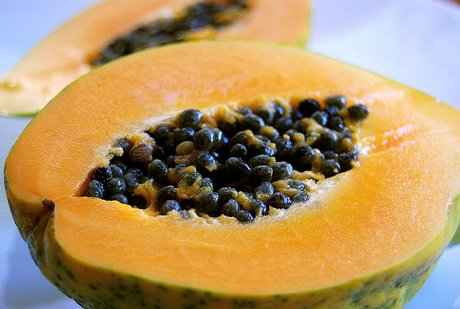What is Vitamin E?
Here we address the question of what is Vitamin E? What role does it play in the body? How it functions? What are its benefits? And which foods contain it.
Vitamin E, known primarily as a fat-soluble vitamin, plays a major role in protecting body cells from free radicals; the reactive molecules that often cause damage to the cells.
The term Vitamin E basically describes eight types of antioxidants: four tocotrienols namely: alpha-, beta-, gamma-, and delta-; and four tocopherols, alpha-, beta-, gamma-, and delta-. However, the only active form of vitamin E that is maintained in the human body is the alpha-tocopherol, and this is the vitamin E form that is found in the largest quantities in tissues and blood.
The Role of Antioxidants in the Body
Antioxidants are needed by the body so as to protect it against the damaging effects caused by free radicals, molecules that carry unshared electrons. Cell damage caused by free radicals can contribute to the development of cancer and cardiovascular diseases. Unshared electrons can react rapidly with oxygen, as they are highly energetic. This leads to the formation of reactive oxygen species (ROS).
When the body converts food into energy, it also forms ROS endogenously. It is therefore important that there is a presence of available antioxidants, as these are responsible for protecting cells from ROS and their damaging effects. The human body is highly exposed to many sources of harmful molecules, including but not limited to air pollution, sun’s ultraviolet radiation, smoke, and other environmental exposures. ROS are included in the organelles’ signaling mechanisms.
Vitamin E Function
Aside from its role as an antioxidant, vitamin E is highly involved in the function of the immune system, gene expression regulation, cell signaling, and other metabolic processes as shown primarily by vitro studies of cells.
The alpha-tocopherol prevents the movement of protein kinase C, which is an enzyme that is involved in the differentiation in smooth muscle cells, monocytes and platelets; and in cell proliferation. Vitamin E also aids in increasing the expression of two enzymes that destroy arachidonic acid metabolism and increases the endothelium’s release of prostacyclin, which in turn can dilate blood vessels while inhibiting platelet aggregation.
Vitamin E Deficiency
This type of deficiency has been observed in people with fat malabsorption syndromes, genetic defects that affect the alpha-tocopherol transfer protein, and those with severe malnutrition. Children with cholestatic liver disease or cystic fibrosis, who have are incapacitated to absorb fat-soluble vitamins and dietary fat, can develop symptomatic vitamin E deficiency. Neurological symptoms, myopathy or muscle weakness, peripheral neuropathy or injury to the sensory nerves, ataxia or impaired balance and coordination, and pigmented retinopathy or damage to the retina of the eye can result from having severe deficiency of vitamin E. Because of this, individuals who have developed ataxia, retinitis pigmentosa, or peripheral neuropathy needs to be screened and tested for vitamin E deficiency. Infants are highly susceptible to vitamin E deficiency as they are undergoing rapid development of the nervous system.
Due to the fact that the digestive tract needs fat in order to absorb vitamin E, those individuals with fat-malabsorption disorders are more prone in becoming vitamin E deficient than those without such kind of disorders. Some of the symptoms of vitamin E deficiency include ataxia, retinopathy, peripheral neuropathy, impairment of the immune response, and skeletal myopathy. Vitamin E is now often used in the treatment of Acne.
The Recommended Dietary Allowance (RDA Vitamin E)
The former recommended dietary allowance (RDA Vitamin E) was 10 mg/day for men and 8 mg/day for women. In 2000, the Food and Nutrition Board of the Institute of Medicine revised the RDA, which was largely based on the results of research conducted in the 1950’s on men that were fed a vitamin E deficient diet.
|
AGE |
FEMALES (mg/day); IU/day |
MALES (mg/day); IU/day |
| Infants 0-6 months | 4 mg (6 IU) | 4 mg (6 IU) |
| Infants 7-12 months | 5 mg (7.5 IU) | 5 mg (7.5 IU) |
| 1 to 3 years | 6 mg (9 IU) | 6 mg (9 IU) |
| 4 to 8 years | 7 mg (10.5 IU) | 7 mg (10.5 IU) |
| 9 to 13 years | 11 mg (16.5 IU) | 11 mg (16.5 IU) |
| 14 to 18 years | 15 mg (22.5 IU) | 15 mg (22.5 IU) |
| 19 years and older | 15 mg (22.5 IU) | 15 mg (22.5 IU) |
| Pregnant | 15 mg (22.5 IU) | – |
| Lactating | 19 mg (28.5 IU) | – |
Vitamin E Food Sources
It is essential to have sufficient intake of vitamin E in order for the body to properly function.

Good Vitamin E food sources of alpha-tocopherol are seeds, nuts, and vegetable oils. Significant amounts are also present in fortified cereals and green leafy vegetables. Gamma-tocopherol is found in corn, soybean, canola and other vegetable oils and food products. Some of the foods that are naturally rich in vitamin E include spinach, tomatoes, peanuts, papayas, asparagus, pumpkin, peaches, kale, lima beans, fish, salmon, broccoli, kohlrabi, celery, egg, grapefruit, blueberries, and onions. For further information visit the following pages Vitamin E Rich Foods and Vitamin E Rich Foods List.
Resources and Further Reading
Papaya photograph by JanineOMG. ODS; LPI: Harvard: EDIS; PSU.

